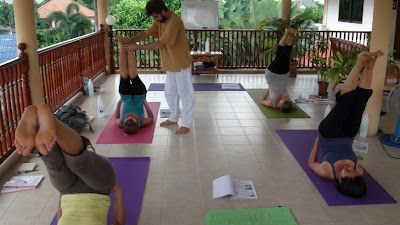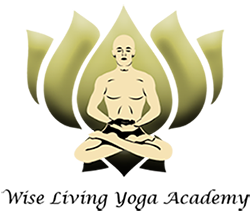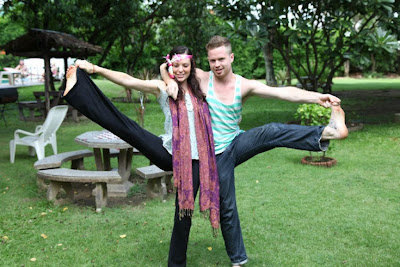Millions of people head towards Asia every year to have (besides the travelling experience) an encounter with eastern philosophies and practices which allows for self-healing, self-discovery and self-empowerment. Among alternative medicine systems, therapies, and many other technical systems (including massage, martial arts, dances, etc, etc) one of the famous and inspiring subjects that attract people to Asia is Yoga.
Although most people think, or like to think, of Yoga as a physical system, in reality it is an ancient and traditional system of Indian Philosophy and Disciplines that emphasizes on a holistic way of living which allows for a deep transformation, awareness and positive changes, not only on the physical, but also on the mental, social and spiritual planes of the human personality.
Traditionally, Asanas (postural training) is only one part of Yoga. Certain sets of conduct regulations (Yamas) and observances (Niyamas) throughout one’s own life form the very foundation of Yoga. Only then follows Asanas. The next step being control of bio-energy through breathing techniques (Pranayamas). Eventually withdrawal of senses (Pratyahara) will be achieved. Following stages are concentration (Dharana), meditation (Dhyana) and finally leading to total absorption in pure consciousness state (Samadhi). This is the goal of Yoga.

The stages described above are known as the “Eight-fold Path of Yoga” and the understanding of these disciplines and the systematic implementation of them in one’s own life is what is meant by “Classical Yoga”. The problem is that Yoga is becoming too much commercial and many teacher and so called “Yogis” have very little or no understanding of the Yoga path in its entirety.
Yoga has become just a matter of performing some “stunt moves” on a rubber mat. But, the truth is that, even for the physical training, if the right attitude and feelings are not present then the Yoga exercises will be just like any other exercise. It will, of course, bring benefits to the practitioner, but that will be only partial, not the real life transforming experience that one may be looking for. As we have seen, more and more, people are realizing this, and there is somehow, a search and an interest for going back to Traditional Yoga.

The first question is: where to go to learn Traditional Yoga? The most obvious answer would be: “India”. But nowadays even in India, commercial Yoga has taken over, and you can meet with either a good or a bad teacher or school, in India, or in any other Asian country. Literally thousands of workshops, retreats and teacher training courses are being offered throughout South East Asia, in countries like Thailand. And for one desiring to have an authentic Yoga experience (instead of just learning some acrobatic postures here and there) a good amount of research is necessary, before choosing a teacher or a course.
And which type of course? Well, the best way to absorb Yoga is to make it a part of one’s own life and then sharing it with others and teaching. That’s why more and more people are looking for Yoga Teacher Training Courses, because, besides being provided with the learning experience, at the end, one can be qualified and certified as a Yoga Teacher.
For this kind of program, the advice would be:
First, one should not undertake such a program only with the certification in mind, but to take it with a sincere interest in self-development and motivated by an altruistic desire to help one and others. Second, luxurious retreats usually divert the focus from the Yoga objectives, not serving the real purpose of simple, ecological and modest lifestyle which is in the core of Yoga. Then, choosing a school which follows a genuine Yoga lineage which upholds the traditional values of Yoga. Be aware of self-proclaimed gurus & too many mixture and fusions of “Yoga styles”.
Finally, if the program is a full immersion experience, that should enable one to live a yogic and holistic lifestyle which means, having a residential course, following a well structured routine including healthy diet arrangements and encouraging a meditative mood. Further, it should include a serious study of traditional Yoga texts like “Yoga Sutras of Patanjali” and “Bhagavad Gita”. Practice and theory should go hand in hand. Of course the curriculum should also include anatomy & physiology classes, methodology and teaching practice.
But one thing is for sure, a Yoga course, especially if it’s a Teacher Training, which only teaches Asanas, and does not encourage a yogic lifestyle (having a good routine, vegetarian diet, abstaining from intoxicants – for at least 1 month period) and does not include the study of the Yoga philosophy, is certainly not imparting authentic Yoga. In here I would quote Leonardo da Vinci who said:
“He who loves practice without theory is like the sailor who boards ship without a rudder and compass and never knows where he may cast”.
So, if you are travelling throughout South East Asia don’t miss the opportunity to find a good Yoga course and perhaps even return home certified and a Yoga Teacher.
This article was written, to be published at the South East Asia Backpacker Magazine, by Jeenal Mehta & Daniel Fonseca, co-founders of Wise Living Yoga Academy which is authorized to impart Yoga Teacher Training Courses on the tradition of The Yoga Institute of Santacruz in Mumbai, India – the world’s oldest organized Yoga Institution. The residential programs are held regularly in Bali (Indonesia) & Chiang Mai (Thailand) throughout the year and are accredited by the Yoga Alliance at the 200 hours level, allowing the graduates to teach Yoga in any part of the world.
Please follow the links to know more about our YTT courses 200 hours in 2012/2013:




No Comments